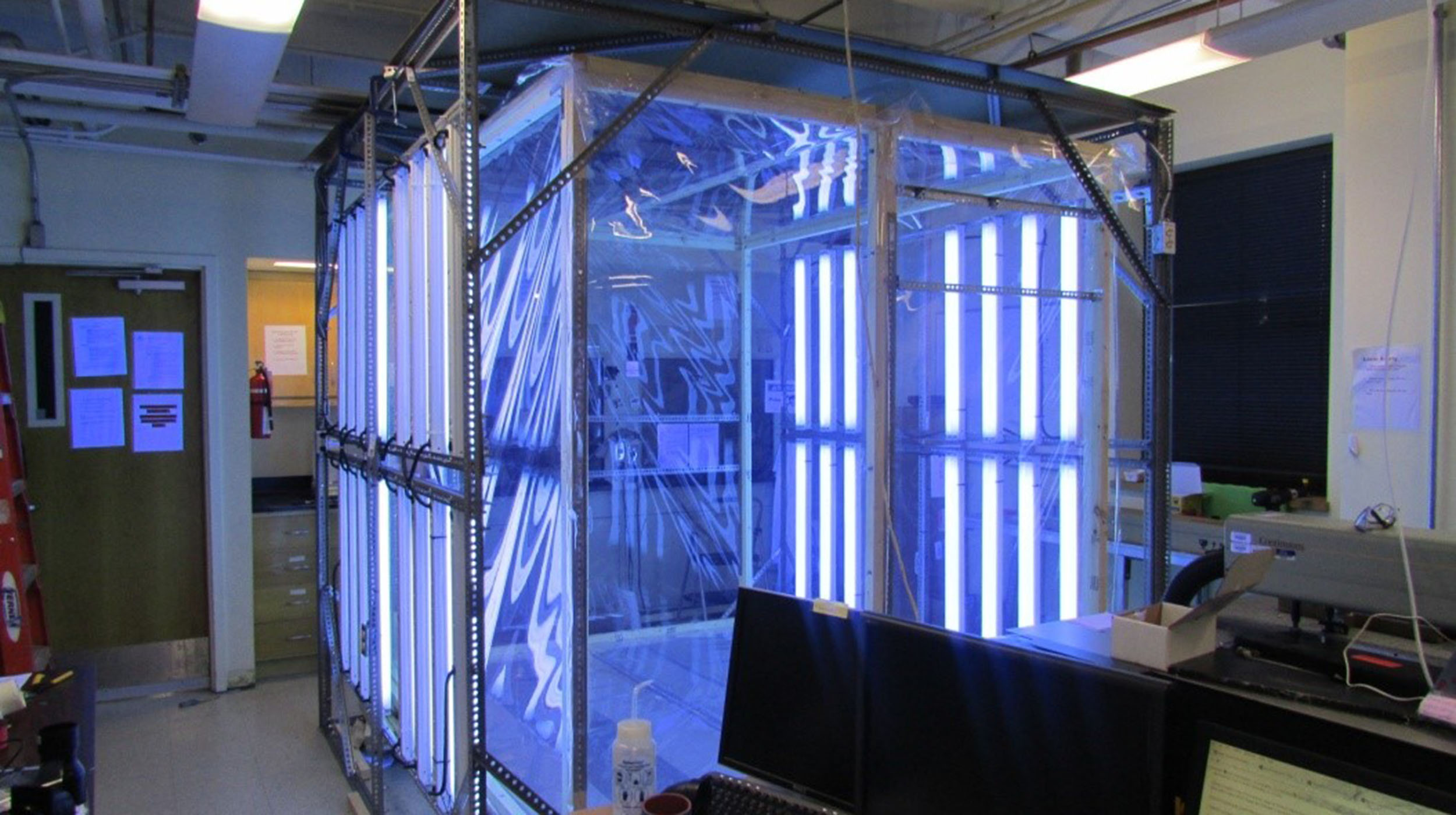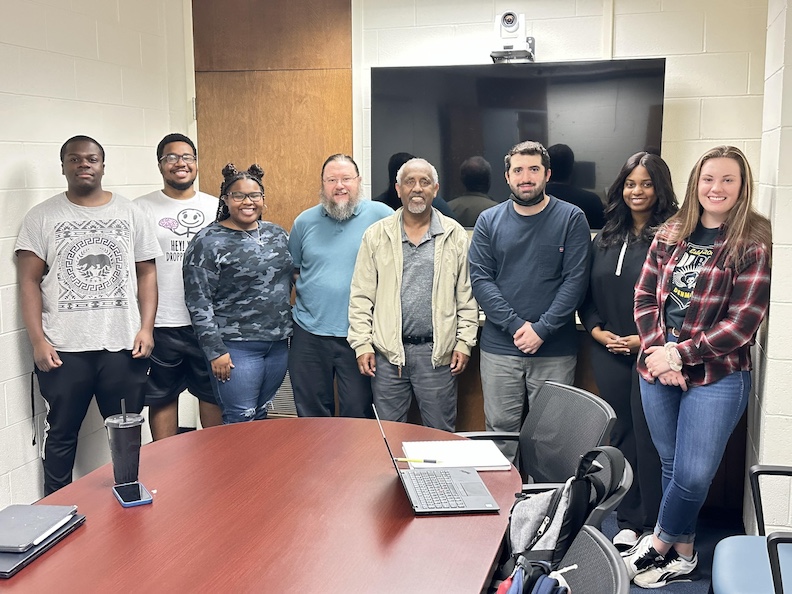Atmospheric Science and Meteorology
The Atmospheric Science and Meteorology group conducts research on atmospheric systems ranging: (a) from microscale (biomass burning aerosols, wildfire/aviation/sea-spray turbulence, tornadoes), mesoscale (snow/ice-atmosphere interaction, tropical/moist convection, orographic effects, severe local storms), to large scale (tropical cyclones and waves, Arctic cyclones, and polar climate) systems; (b) from tropical (cyclones and waves), midlatitude (storms, polar/subtropical jets), to polar (snow/ice, Arctic cyclones) regions; and (c) from short (aerosol emission, turbulence, tornadoes) to long (regional climate in polar and tropical regions; biomass impacts on climate) terms, using measured, observed, or remotely-sensed data by laboratory, field, or numerically-modeled experiments.
Faculty
Solomon Bililign (Professor) conducts research in Atmospheric Chemistry/Physics with a focus on laboratory and field studies of chemical and optical properties of biomass burning aerosols and their impact on health and climate. He also does air quality field measurements of emissions from anthropogenic sources.
Yuh-Lang Lin (Senior Scientist and Professor) conducts research on atmospheric dynamics and modeling of tropical cyclones, orographic effects on airflow and weather systems, wildfires, tornado environment, moist convection, gravity waves & turbulence, severe local storms, and cloud microphysics.
Ademe Mekonnen (Associate Professor) research is focused on the interaction between atmospheric tropical waves and different types of convection, including tropical cyclone development. He has a broad interest in medium to long-range forecast problems, tropical climate variability, and change.
Jing Zhang (Professor) is interested in polar research with a focus on the weather and climate modeling studies for the Arctic and Antarctic regions using an in-house developed WRF-ice model. She studies WRF-ice, a snow/ice enhanced Weather Research and Forecasting (WRF) model, includes thermodynamic sea ice module, as well as newly coupled ice sheet and double-moment blowing snow modules.
Research Projects
Bililign Group Research
 Research in Bililign group involves the use of spectroscopic techniques and theoretical methods for atmospheric applications: The focus is measuring in the laboratory and the field the optical and physio-chemical properties of Biomass Burning (BB) aerosol to understand the role of BB Aerosol on climate, regional weather, air quality, and health. We investigate:
Research in Bililign group involves the use of spectroscopic techniques and theoretical methods for atmospheric applications: The focus is measuring in the laboratory and the field the optical and physio-chemical properties of Biomass Burning (BB) aerosol to understand the role of BB Aerosol on climate, regional weather, air quality, and health. We investigate:
1) How relative humidity (RH) photochemical aging morphology and burn conditions, fuel type influence the size distribution, optical properties, and chemical properties of BB aerosols produced from sub-Saharan Africa Biomass Fuels.
2) Toxicity of Complex Aerosols from Biomass Burning
3) Field measurements of power plant emissions and wildfire emissions and their impact on Air Quality.
<span">Talks and Seminars>
- Bililign Group feature in the American Scientist podcast: link
- Bililign group presentations at American Geophysical Union 2020
- Prof. Bililign's invited talk Columbia University Climate School: link
- Workshop on a Pilot Design for Air Quality in Africa- link
- Solomon Bililign, “The Impact of Climate and Weather Extremes on Air Quality and Water Quality”, Presented at The international Conference on Environment and Society EAS2022, July 4-6, 2022, Addis Ababa , Ethiopia, https://eas-conference.fiu.edu/wp-content/uploads/2022/05/Posters-v2.pdf
- Solomon Bililign: Colloquium at Lund University, May 23, 2022, and Botswana International University of Science and Technology, July 20, 2022 “Laboratory Studies of Particulate Matter Emissions from African Biomass Fuels” https://lu.box.com/s/bpofg27ksnutgowpjepcaftif8cgppj5
- Solomon Bililign, Marc Fiddler, Rudra Pokhrel, “The role of Physics in Environmental and Air quality Research” APS March 2022 meeting, Chicago, IL. https://meetings.aps.org/Meeting/MAR22/Session/K01.3
- Solomon Bililign: Colloquium at Columbia “Impact of burning conditions on Morphology, Hygroscopicity and Emission Factors of Biomass Burning Aerosol. Columbia Climate school-Lamont Doherty Earth Observatory- Earth Science Colloquium Series, Oct 29, 2021, https://www.ldeo.columbia.edu/2021-2022-earth-science-colloquium-schedule
- Solomon Bililign, Laboratory studies of Optical Properties of Biomass Burning Aerosols from Sub-Sharan Africa Biomass fuels and impact on climate, American Physical Society Meeting, (Virtual) March 2021 https://meetings.aps.org/Meeting/MAR21/Session/U71.257
- Megan Mouton, Kotiba A. Malek, Markie’Sha James, Rudra Pokhrel, Marc Fiddler, Akua A. Asa-Awuku, and Solomon Bililign, The Hygroscopic Properties of Biomass Fuels-Eucalyptus and Dung under Different Combustion Conditions. Submitted American Geophysical Union Fall Meeting, 2021 https://agu.confex.com/agu/fm21/meetingapp.cgi/Paper/820866
- Janica Gordon, Kelsey R. Bilsback, Marc N. Fiddler, Rudra P. Pokhrel, Emily V. Fischer, Jeffrey R. Pierce, Solomon Bililign, The Effects of Trash, Residential Biofuel, and Open Biomass Burning Emissions on Local and Transported PM5 and its Attributed Mortality in Africa. Submitted American Geophysical Union Fall Meeting, Dec. 2021, and Submitted American Meteorological Society, Jan. 2022 https://ams.confex.com/ams/102ANNUAL/meetingapp.cgi/Paper/392046
- Chelia Thompson, Scott Herndon, Tara Yacovitch, Rudra Pokhrel, Marc Fiddler, Solomon Bililign, Understanding the Variability of Emissions Factors of Volatile Organic Compounds and Particulate Matter during the 2019 Western United States Wildfire Season. Submitted American Geophysical Union Fall Meeting, 2021 https://agu.confex.com/agu/fm21/meetingapp.cgi/Paper/822638
- Marc N. Fiddler Rudra P. Pokhrel, Janica Gordon, Solomon Bililign, Laboratory Measurements of Emission Factors of Pollutants emitted by Biomass Burning of African Fuels. American Meteorological Society, 2022- https://ams.confex.com/ams/102ANNUAL/meetingapp.cgi/Paper/392047
- Solomon Bililign, Marc N Fiddler, Rudra P. Pokhrel, “Role of Physics in Environmental and Air Quality Research, American Physical Society, March 2022 Meeting, https://meetings.aps.org/Meeting/MAR22/Session/K01.3
- Solomon Bililign, “Interdisciplinary undergraduate Research Experience and Flexible Majors to Increase Diversity on Geosciences,” Presented at the Geological Society of America Meeting, Reston, VA March 2023, Geological Society of America Abstracts with Programs. Vol. 55, No. 2, 2023 doi: 10.1130/abs/2023SE-384941 https://gsa.confex.com/gsa/2023SE/meetingapp.cgi/Paper/384941
- Solomon Bililign, “Comparisons of laboratory and field studies of chemical and optical properties of emissions from African Biomass Fuels” Presented at the Follow up workshop on a pilot design for air quality in Africa, Kigali, Rwanda, Jan 2023- https://cpaess.ucar.edu/sites/default/files/2023-01/kigali-workshop-agenda-final-1-9-23.pdf
- Solomon Bililign, “Inseparable Link between Air pollution and Climate Change” APS March meeting, Las Vegas, Nevada https://meetings.aps.org/Meeting/MAR23/Session/B65.9
- Solomon Bililign, “Laboratory Studies of Optical and Chemical properties of PM Emissions from African Biomass Fuels” Seminar at NOAA Chemical Sciences Laboratory, Nov. 2022, https://csl.noaa.gov/seminars/2021/
- Vernon Morris, Martin Jimenez-Navarro, Janica Gordon, Wogayehu Legese, Marc Nicholas Fiddler, Tshepho Manyothwane, Bosa Mphoeng, , Bisrat Kifle, Gizaw Mengistu Tsidu and Solomon Bililign, “ Characterization of Wintertime Particulate Collected in Palpaye, Botswana.” AGU, 2022, Chicago, IL. https://agu.confex.com/agu/fm22/meetingapp.cgi/Paper/1181244
- Solomon Bililign, Megan Mouton, Kotiba Malek, Markiesha James, Marc Fiddler, Akua Asa Awaku, “Cloud Condensation Nuclei Activity and Hygroscopicity of Fresh Biomass Burning Particles as a Function of Burning Conditions” MedGU-22, Presented in Marrakesh, Morocco https://www.performer2022.medgu.org/author
- Megan Mouton, Vaios Moschos, Marc N. Fiddler, Barbara J. Turpin, Jason D. Surratt, and Solomon Bililign, “The Optical Properties of African Biomass Fuel-derived Carbonaceous Aerosol Emissions under Different Relative Humidity and Aging Conditions”, AGU 2022, Chicago IL. https://agu.confex.com/agu/fm22/meetingapp.cgi/Paper/1091209
- Vaios Moschos, Cade Christensen, Megan Mouton, Marc N. Fiddler, Markie’Sha James, Barbara J. Turpin, Solomon Bililign, and Jason D. Surratt, “Molecular Composition of Brown Carbon Aerosol from the Combustion of African Solid Fuels.” AGU 2022, Chicago IL. https://agu.confex.com/agu/fm22/meetingapp.cgi/Paper/1063587
- Markie’Sha James, Vaios Moschos, Megan Mouton, Marc Fiddler, Jason D Surratt and Solomon Bililign, “Real-Time Chemical Characterization of Primary and Aged Organic Aerosols from African Biomass Burning” AGU 2022, Chicago IL. https://agu.confex.com/agu/fm22/meetingapp.cgi/Paper/1079120
- Janica Gordon, Marc Nicholas Fiddler, Vaios Moschos, Tshepho Manyothwane, Bosa Mphoeng,Wogayehu Legese, Martin Jimenez-Navarro, Bisrat Kifle, Gizaw Mengistu Tsidu and Solomon Bililign “Field Measurements of some Criterion Pollutants using Filter Collection in Botswana, Africa” AGU 2022, Chicago, IL. https://agu.confex.com/agu/fm22/meetingapp.cgi/Paper/1078384
- MEGAN MOUTON, MarkieSha James, Kotiba A. Malek, Rudra Pokhrel, Marc Fiddler, Akua Asa-Awuku, Solomon Bililign,” Cloud Condensation Nuclei Activity and Hygroscopicity of Fresh Biomass Burning Particles as a Function of Burning Conditions” Presented at the 40th Annual Conference of the American Association of Aerosol Research, Oct 3-7, 2022, Raleigh, NC. https://aaarabstracts.com/2022/view_abstract.php?pid=145
-
Solomon Bililign, PLENARY Laboratory Studies of Particulate Matter Emissions from African Biomass Fuels, Invited Plenary talk -International Conference on African Air Quality, Oct 11-14, 2022-Virtual- https://indico.cern.ch/event/1121006/timetable/#20221011
Bililign Group Funding:
- NSF 1831013 HBCU-Excellence in Research: Radiative Effects of Biomass Burning Aerosols Laboratory and Field Measurements and Modeling of Climate and Health Impacts. NSF, 9/1/18-8/31/21, Amount $1,000,000.
-
NSF-1555479: Studies of Optical and Chemical Properties of Biomass Burning Aerosols. NSF, 8/1/2015-7/31/21. Amount $515,000.
-
NSF-2100708: Biomass buring Aerosol - molecular level characterization of aging conditions on optical and chemcial Properties. NSF, 09/1/21-08/31/24, Amount $869,910.
-
NSF-2138096: Supplement award- Purchase of Aethalometer and CO analyzer. NSF, 07/21-06/22, Amount: $40,000.
-
DoS: International networking, knowledge sharing, and capacity buiilding for improved air quality in four East African countriies, Sub award with Columbia University- 10/20-9/23, Amount $292,729.
-
DOE: DE-SC0023051 Title: Studies of optical and chemical properties of aged and fresh biomass burning absorbing aerosols for climate models Amount $123,100 Period: 8/15/22-2/29/24
-
NSF # 2221800 Supplement to Grant NSF # 210078 – Replace Laser system, $55,983- 2022
-
NSF#2304083 Supplement to Grant NSF # 210078 – Conduct more chemical analysis of filter samples $94,004- 2022-2023
-
NSF # 2325677 Supplement to Grant NSF # 210078- Host two teachers for summer research $19,400, 2023
Lin Group Research
- NSF-1831013 Excellence in Research: Dynamics of Orographic on Major Wildfires in the Southwest U.S. under Diverse Mesoscale Environments. NSF, 6/1/19-5/31/22. Amount $498,373
- Testing and Training of the Cloud WRF Model for the Atmospheric Research Community Developed by NCAR. NSF/NCAR, 10/1/18-9/30/20.
- Improving Understanding and Prediction of Extreme Rainfall Associated with Typhoon and Mei-Yu Fronts Passing over Taiwan’s Central Mountain Range (part of PRECIP), NSF/CSU, 3/1/19-2/28/22
- GP-EXTRA: Pathways to atmospheric science through immersion in geoscience research. NSF, 9/1/16-8/31/20.
Mekonnen Group Research
- Multiscale interaction between easterly waves and different types of deep convection and the implication on Atlantic tropical cyclone-genesis.
- The upscale impact of well-organized and large-scale convective systems on easterly wave initiation, maintenance, and structure.
- The impact of large-scale waves (MJO, Kelvin waves, etc.) on convective organization and diurnal cycle over tropical Africa.
- Mechanisms of extended active and break rainfall episodes over Africa and the implication for seasonal forecasts.
- Climate variability: The recent heavy and wet rainfall years over Africa and dynamic mechanisms.
Zhang Group Research
- Present and projected future forcings on Antarctic Peninsula glaciers and ice shelves using the Weather Forecasting and Research (WRF) Model. NSF, 2017-2021.
- Modeling Arctic Storms and Impacts of Diminishing Sea Ice. DoE, 2020-2023.
Opportunities
- Geopaths program for students interested in atmospheric science. Pays up to $3000/semester. Contact: bililign@ncat.edu
- International research experience in Geosciences-covers travel, lodging, and $500/week stipend:
https://old.ncat.edu/cost/departments/phys/people/bililign/International%20Research%20Opportunity.html - Undergraduate research in Atmospheric Chemistry Lab Up to $3000/semester. Contact: bililign@ncat.edu
-
Undergraduate Student opportunities are available with Lin lab. Contact: ylin@ncat.edu
Opportunities for research assistantship to work towards M.S. in Physics or Ph.D. in Applied Physics and Atmospheric Sciences are available. Please contact the faculty in the Atmospheric Sciences by email.



